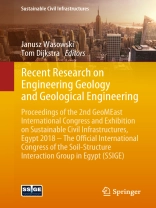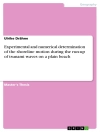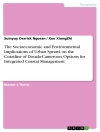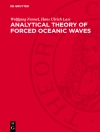The ongoing population growth is resulting in rapid urbanization, new infrastructure development and increasing demand for the Earth’s natural resources (e.g., water, oil/gas, minerals). This, together with the current climate change and increasing impact of natural hazards, imply that the engineering geology profession is called upon to respond to new challenges. It is recognized that these challenges are particularly relevant in the developing and newly industrialized regions.
The idea beyond this Volume is to highlight the role of engineering geology and geological engineering in fostering sustainable use of the Earth’s resources, smart urbanization and infrastructure protection from geohazards. We selected 19 contributions from across the globe (16 countries, five continents), which cover a wide spectrum of applied interdisciplinary and multidisciplinary research, from geology to engineering. By illustrating a series of practical case studies, the Volume offers a rather unique opportunity to share the experiences of engineering geologists and geological engineers who tackle complex problems working in different environmental and social settings.
The specific topics addressed by the papers included in the Volume are the following: pre-design site investigations; physical and mechanical properties of engineering soils; novel, affordable sensing technologies for long-term geotechnical monitoring of engineering structures; slope stability assessments and monitoring in active open-cast mines; control of environmental impacts and hazards posed by abandoned coal mines; assessment of and protection from geohazards (landslides, ground fracturing, coastal erosion); applications of geophysical surveying to investigate active faults and ground instability; numerical modeling of seabed deformations related to active faulting; deep geological repositories and waste disposal; aquifer assessment based on the integrated hydrogeological and geophysical investigation; use of remote sensing and GIS tools for the detection of environmental hazards and mapping of surface geology.
Зміст
Slope stability analysis and suggestive measures for an active landslide in Indian Himalaya.- Analysis of a combined circular-toppling slope failure in an open-pit.- Reflection of Processes of Two-Phase Filtration in Fluid Saturated Hierarchic inclusion in a Block Layered Medium by Data of Active Wave Geophysical Monitoring. Evaluation of the landslide in Erzurum ski-jumping complex-A Case Study Geological Investigation and Risk Assessment for Disaster Management of Merapi Volcano and Surrounding Area, Yogyakarta Special Territory, Indonesia.- Acquisition and Analysis of Surface wave data in the Indo Gangetic Basin.- Investigation of turbulent flow characteristics along the streamwise centerline in the interior and wake region of emergent and sparse vegetation patch.- Volcanic Hazards and the Decline of Mataram Kingdom in the Central Java, Indonesia.- Causal Analysis and Stability Evaluation of Loess Landslide in Yili region of Xinjiang – A Case Study of Alar Village Landslide.- Artificial Neural Networks for rock and soil cutting slopes stability condition prediction.- Landslide Susceptibility Assessment Using Frequency Ratio Technique – A Case Study of NH67 Road Corridor in the Nilgiris district, Tamilnadu, India.- On the development of ground-based and drone-borne radar system.- Is Gas Hydrate a Non-Nuclear Lethal Weapon?.- Geotechnical Engineering behavior of mudstone formations of Al Wadi Al Gadid region in Egypt.
Про автора
Dr. Janusz Wasowski is a research geologist at CNR-IRPI (National Research Council – Institute for Geo-hydrological Protection) in Bari, Italy. He is also the Editor-in-Chief of Engineering Geology. Since 2011 he has held the positions of Visiting Professor at the Research School of Arid Environment and Climate Change, Lanzhou University, Gansu, China and of Science Officer of the Natural Hazards Group Programme, European Geosciences Union (EGU).
He is an internationally recognized scientist in the field of engineering geology, natural hazards and applied remote sensing. For over 25 years Dr. Wasowski’s work has covered a broad spectrum of research topics ranging from slope instability and landslide assessment, collateral seismic hazards, geotechnical field investigation and in situ monitoring, to exploitation of air/space-borne remote sensing and geophysical surveying in engineering geology. He has also served as a consultant for the National Department for Civil Protection, Italy, the Government of Gansu Province, China, and the Centre National de l’Information Géo-Spatiale, Haiti, focusing on landslides and other geohazards and on the application of satellite multi-temporal interferometry for monitoring terrain deformations and infrastructure instability.
Since 2007 Dr. Wasowski has been a member of the Editorial Board of Engineering Geology (Elsevier) and the Quarterly Journal of Engineering Geology and Hydrogeology (The Geological Society, London). He is the author/co-author of over 100 articles/book chapters and the guest editor of 11 special issues published in international scientific journals.
Tom is an engineering geologist/geomorphologist with an interest in geohazards, specifically landslides and climate change. Tom graduated from Utrecht University (NL) in 1987 with a degree in Physical Geography with Geomorphology and Quaternary Geology as specialisations and Soil Science and Palynology as additional subjects. In 1988, he moved from Utrecht University to the University of Leicester to join a large European-Chinese research team addressing loess landslide geohazards in the Lanzhou region of Gansu Province, China. This initiated a series of short-term research contracts at the universities of Royal Holloway, Utrecht and Loughborough. In 2000, he was awarded his Ph D at Utrecht University for his work on ‘Loess slope instability in the Lanzhou region, China’ and he maintains a keen interest in geohazards research in Central China. In 1995, Tom joined the University of Sussex as a lecturer in Physical Geography and in 1997 he moved to Coventry University as a Senior Lecturer in Geotechnology. In 2001 he moved back to Loughborough University. A major aspect of his research is on climate change effects on UK slopes, including engineered earthwork transport infrastructure slopes. This started when he managed the UK response to IGCP 425 (IUGS / UNESCO) and, in 2000, introduced a new theme on ‘Slope Instability in a Context of Progressive Environmental Change’. This research focus intensified when at Loughborough, including the EPSRC-funded UK network CLIFFS, research projects such as FUTURENET and i SMART, and the EU-funded COST TU1202 project. Research topics included developing an architecture for transport infrastructure earthworks resilience in a context of climate change, integrating a water balance model approach into transport network performance, and research into engineered earthworks deterioration. From 2012, he spent five years at the British Geological Survey where he enjoyed working on a wide range of collaborative projects addressing among others multi-temporal landslide inventory establishment in St Lucia, continental-scale landslide susceptibility and hazard assessments, and developing a water balance model approach to underpin the issuing of daily landslide hazard assessments as part of the Natural Hazard Partnership. A key aspect of his research focuses on the interactions between geohazards and communities and this has given him the opportunity to engage with multi-disciplinary research contracts in China, India, Nepal, the Caribbean. In September 2017, Tom re-joined the team at Loughborough University to continue this work and combine it with his passion for communicating knowledge with the students.
Tom is on the editorial boards of Engineering Geology and the Quarterly Journal of Engineering Geology and Hydrogeology. He has more 100+ publications and has been the editor of special issues on topics such including geohazards and landslide research in China. He holds honorary research positions at Lanzhou University (Gansu, China) and the BGS. He has supervised three Ph Ds to completion.












